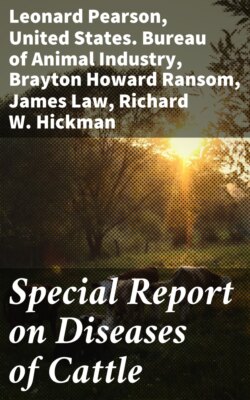Читать книгу Special Report on Diseases of Cattle - Lowe - Страница 95
На сайте Литреса книга снята с продажи.
ERGOTISM.
ОглавлениеThe poisonous effects of ergot (Pls. V, VI) appear chiefly in the winter and spring of the year and among cattle. It is developed among grasses grown on rich soil in hot, damp seasons. Rye seems more liable to ergot than any of our other crops. Of the grasses which enter into the composition of hay, bluegrass is the most likely to become affected. Ergot may also affect redtop, oats, grasses, and grains. On the plant the fungus manifests itself on the seeds, where it is easily recognized when the hay is examined in the mow. The ergotized seeds are several times larger than the natural seeds—hard, black, and generally curved in shape.
The effect of the protracted use of ergot in the feed is pretty well understood to be that of producing a degeneration and obstruction of the smaller arterial branches. The result is to shut off the blood supply to the distal parts of the body, where the circulation is weakest, and thus to produce a mummification or dry gangrene of the extremities, as the ears, tail, feet, etc. Cattle seem to be more susceptible than other animals to the influence of ergot, possibly on account of the slowness of the heart's action. When the effect of the poison has become sufficient to entirely arrest the circulation in any part, the structures soon die. The disorder manifests itself as lameness in one or more limbs; swelling about the ankle which may result in only a small slough or the loss of a toe, but it may circumscribe the limb at any point below the knee or hock by an indented ring below which the tissues become dead. The indentation soon changes to a crack, which extends completely around the limb, forming the line of separation between the dead and living structures. The crack deepens till the parts below drop off without loss of blood, and frequently with very little pus. Ergot may cause serious irritation of the digestive tract, or by acting upon the nervous system it may cause lethargy or paralysis. It also operates to cause contraction of the uterus, and may thus cause abortion.
Treatment.—Regarding the treatment, change of feed and local antiseptics are, of course, indicated. The former may be useful as a preventive, but when the symptoms have appeared the animal is necessarily so completely saturated that recovery is likely to be tedious. Tannin may be given internally in doses of one-half dram twice daily for a few days to neutralize the unabsorbed alkaloids of the ergot. At the same time give castor oil. To dilate the blood vessels give chloral hydrate. Bathe the affected parts with hot water. If sloughing has gone far, amputation must be resorted to.
